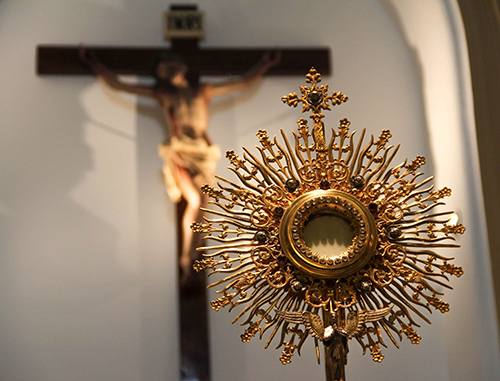
The liturgy of Holy Thursday evening presents us with something of a conundrum, namely where is our focus? Do we focus on the foot washing or do we focus on the institution of the Eucharist?
As a growing young boy, I have no memory of the foot washing ritual as being a significant feature of the liturgy of Holy Thursday. I do have strong memories of the ritual of the procession after communion to what was known as the “altar of repose”.
(Somewhat intriguingly the account of the foot washing occurs only in the Gospel of St. John – if it was such an important event why do not all the Gospel writers record the event?)
The Gospel of St. Mark recounts for us with simple drama the events of that night in the upper room, “While they were eating, Jesus took bread, and when he had given thanks, he broke it and gave it to his disciples, saying, ‘Take it; this is my body.’ Then he took a cup, and when he had given thanks, he gave it to them, and they all drank from it. ‘This is my blood of the covenant, which is poured out for many,’ he said to them.” (Mark 14: 22 – 24).
What is given to those present is ‘bread broken’ and ‘blood poured out’.
We, in turn, have worked tirelessly for generations to put together the broken, poured out Saviour.
I am always somewhat intrigued by the juxtaposition that occurs when small groups gather for a liturgical rite known as Exposition and Adoration of the Blessed Sacrament. The consecrated host is removed from the Tabernacle and placed in a receptacle known as a monstrance. In days past, such receptacles were very elaborate in their design (on many occasions laden with gold and precious stones.) The monstrance is then placed on the altar and individuals and/or groups spend time kneeling and/or sitting in prayer.
Frequently there is, in the same physical space where the monstrance sits, a crucifix – a cross bearing the bruised, battered, and broken body of Jesus. There is already, in our Churches, an opportunity to Adore the Blessed Sacrament, namely the person of Jesus nailed to a tree – “this is my Body broken for you; my Blood shed for you.”
I have often asked myself the question, “why do we need to expose the Blessed Sacrament, when, in fact, that same Blessed Sacrament is already exposed for us in the image of bruised, battered, broken body of the crucified Word made flesh? “
